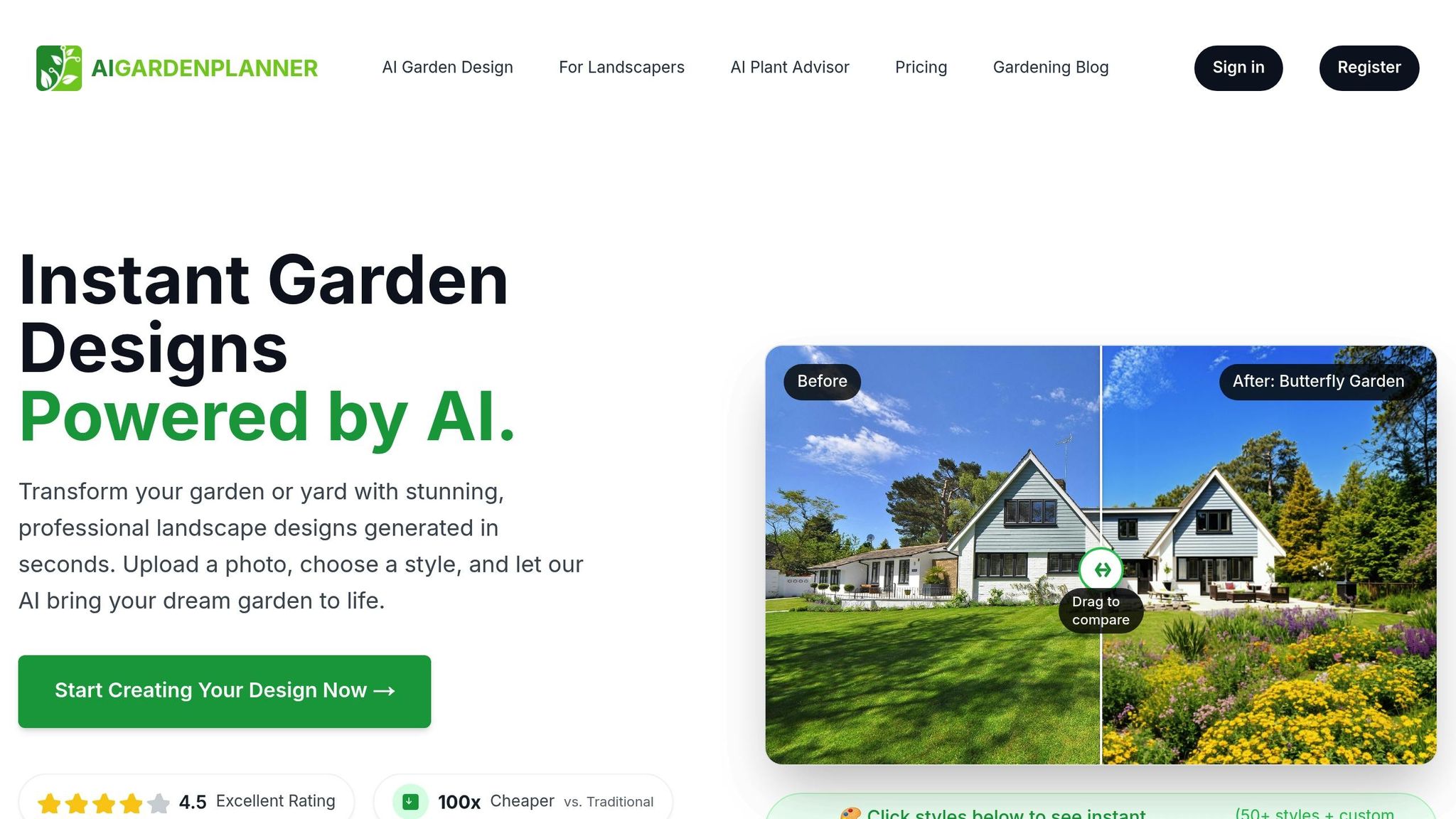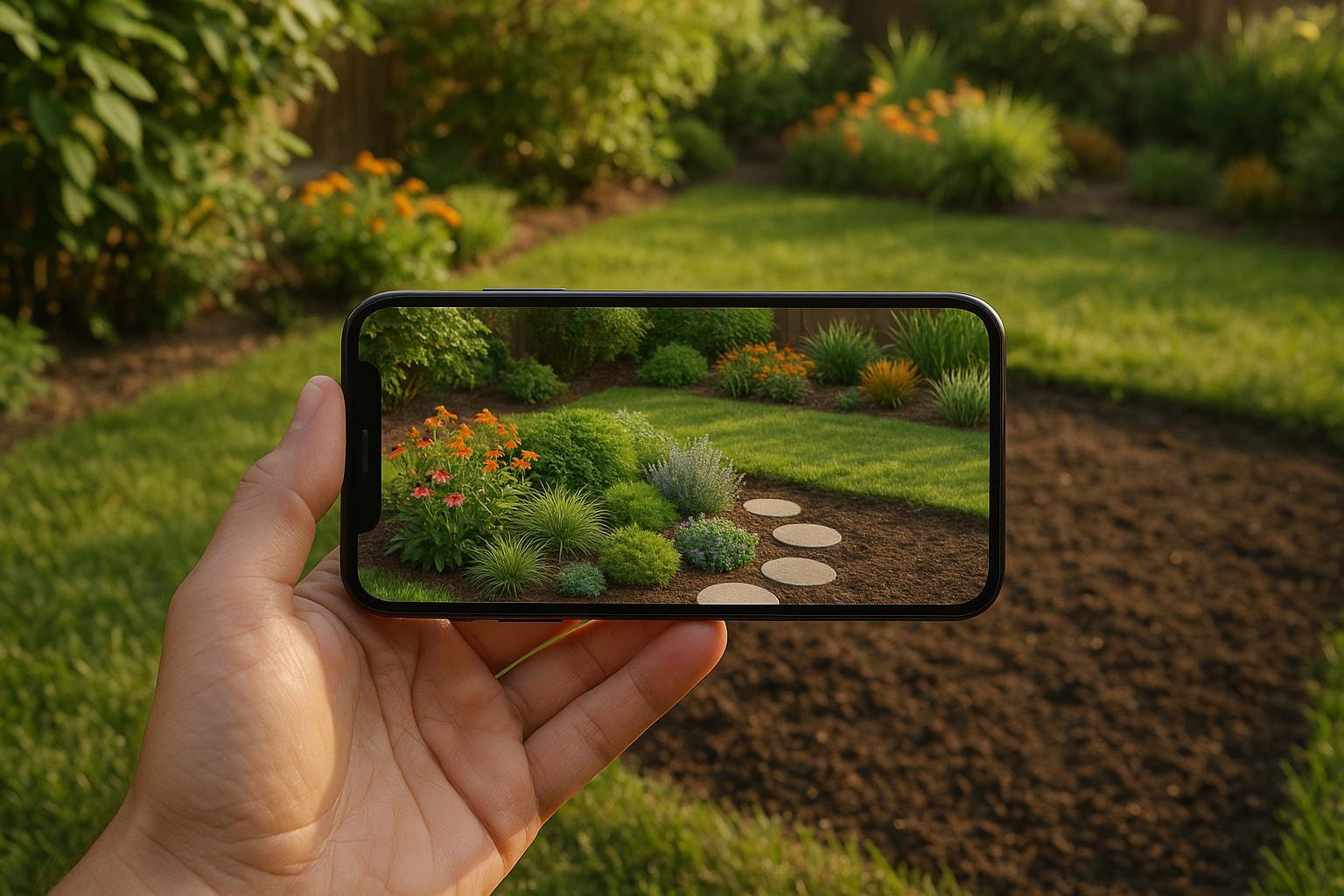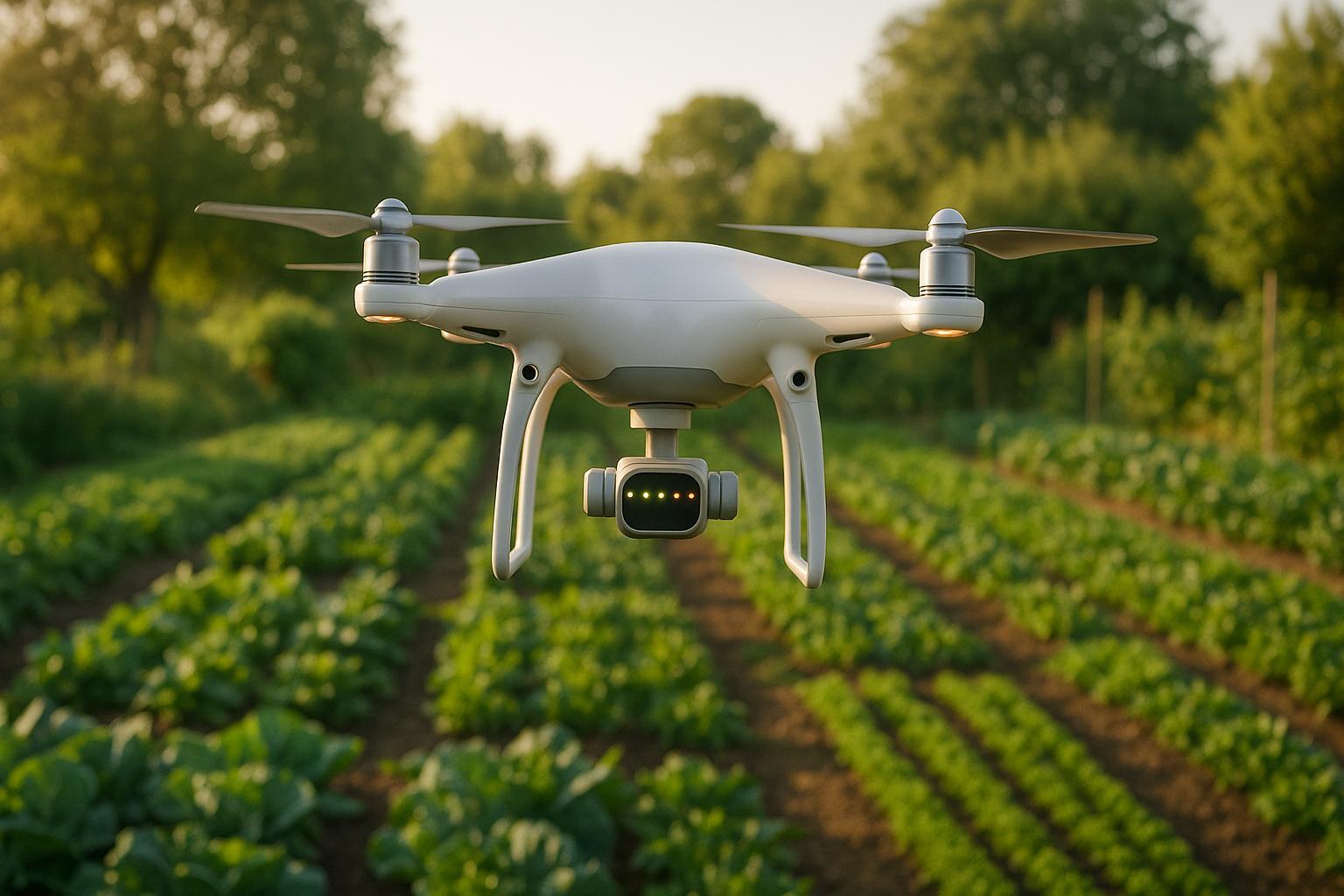How AI Tracks Garden Waste in Real Time

AI is changing how we manage garden waste, making it smarter and more efficient. With tools like sensors and image recognition, AI systems track waste in real time, sort materials automatically, and optimize composting conditions. Here's what you need to know:
- Real-time tracking: Monitors waste types and volumes continuously.
- Smart sorting: Identifies and separates waste with up to 99% accuracy.
- Composting optimization: Ensures ideal conditions for decomposition using sensors for temperature, moisture, and pH.
- Predictive analytics: Anticipates waste patterns and improves scheduling.
These systems reduce landfill waste, lower greenhouse gas emissions, and create better compost for healthier gardens. Whether you're a gardener or part of a waste management team, AI tools simplify the process and improve results.
Smart waste management with intelligent computer vision

Main Parts of AI Waste Tracking Systems
Modern AI waste tracking systems combine cutting-edge sensors and image recognition technology to provide real-time data on waste composition, volume, and processing status. By seamlessly integrating hardware and software, these systems enable precise data collection and practical insights for improved waste management.
Garden Waste Sensors
At the core of these systems are sensor networks that gather a wide range of data. Different types of sensors work together to provide a detailed understanding of waste conditions:
- Ultrasonic sensors: Measure the volume and fullness levels of waste containers.
- Temperature sensors: Keep track of composting conditions and detect unwanted organic materials.
- Humidity sensors: Monitor moisture levels to ensure optimal decomposition.
- Gas sensors: Detect harmful emissions that may arise during the breakdown of waste.
Image Recognition for Waste Sorting
AI-driven image recognition has revolutionized the way waste is sorted. Using advanced cameras and sophisticated algorithms, these systems can identify and categorize various types of garden waste in real time.
"Machine vision has been used in the waste sector for decades. With the growing need for the waste management sector to process and sort materials, the technology's ability to drive digitization and automation will become more vital than ever." - Alisa Pritchard, VP of Marketing at Greyparrot
For instance, industrial-scale image recognition systems utilize high-resolution cameras with advanced zoom features to capture detailed images of waste. These systems then analyze critical attributes like material composition, size, and potential environmental impact.
Data Processing Systems
Once data is collected through sensors and imaging tools, cloud-based platforms take over to process this information. These platforms transform raw data into actionable insights, leading to tangible benefits such as reducing transportation distances by up to 36.8%, cutting costs by 13.35%, and saving time by as much as 28.22%.
"By arming our plant managers with that information, they can now set thresholds or alerts, or study the dashboard and say there's maybe too much hard plastic arriving on this line. That allows them to go back and make adjustments." - Conor McCooey, CIO at Re-Gen
These systems integrate diverse data sources, from smart bins to weather forecasts, to streamline operations. Despite the complexity of the data involved, they maintain sorting accuracy rates ranging from 72.8% to an impressive 99.95%.
Setting Up AI Waste Tracking
To establish an AI waste tracking system, you'll need to focus on selecting the right sensors and integrating software for seamless monitoring. Below, we'll explore the key steps for equipment selection, sensor setup, and software integration to build an efficient system.
Equipment Selection Guide
Choosing the right equipment is the backbone of an effective AI waste tracking setup. Prioritize sensors that deliver reliable data and are built to withstand environmental challenges. Here's a breakdown of essential components to consider:
| Component Type | Key Features | Recommended Specifications |
|---|---|---|
| Soil Sensors | Monitor moisture and temperature | Weather-resistant, Wi-Fi enabled |
| Waste Bins | Track volume and fill levels | Ultrasonic sensors, weatherproof |
| Imaging System | Identify and sort waste | High-resolution cameras, AI integration |
| Data Hub | Centralize processing and connectivity | Cloud integration, remote access |
Make sure to select weatherproof devices with Wi-Fi or Bluetooth capabilities for real-time data tracking.
Sensor Setup Steps
Once you've selected your equipment, proper sensor installation is crucial to ensure accurate data collection. A poorly installed system can lead to errors exceeding 10%. Follow these steps for an effective setup:
-
Pre-Installation Testing
- Test sensors in a controlled environment to confirm functionality.
- Record baseline readings to establish accuracy.
- Verify all components work as expected.
-
Strategic Placement
- Install sensors away from direct sunlight and potential interference.
- Ensure soil sensors are in full contact with the ground to avoid distorted readings.
- Eliminate air gaps that could compromise accuracy.
-
Protection Measures
- Use PVC conduits to shield cables.
- Install weatherproof housing for outdoor components.
- Safeguard electronic parts from environmental damage.
"We help cities and waste collection organizations alike to reduce operational costs by eliminating unnecessary pick-ups, providing dynamic collection routes and schedules for a complete optimization of the collection operations."
– Matti Juutinen, Global Business Development Manager, Ecube Labs
Connecting to Garden Software
Integrating sensors with garden software is an essential step to consolidate and analyze data effectively. A great example is Plant Sentry Squad's implementation in July 2024, which combined Arduino-based sensors, Python-driven deep learning, real-time ThingSpeak monitoring, and automated irrigation systems.
For the best results, include the following features in your software integration:
- Data Validation: Ensure incoming data is accurate and free of errors.
- Alert Systems: Set up notifications for abnormal readings or system issues.
- Backup Power: Incorporate solutions to maintain functionality during outages.
- Cloud Storage: Use secure platforms to store and access data remotely.
The global market for smart gardening tools is projected to surpass $3.2 billion by the end of 2025. By integrating software effectively, you can enhance sensor accuracy and enable real-time waste tracking. This integration lays the groundwork for advanced automation and analysis, which will be discussed in later sections.
sbb-itb-4d6a8dd
🚀 Ready to Reinvent Your Garden?
Join thousands of homeowners who have transformed their gardens using our AI design tool. Upload one photo to explore endless possibilities.
Get your AI garden designs →Live Waste Monitoring
AI-powered real-time waste monitoring brings a new level of precision to managing waste. By continuously analyzing data from sensors and software, this technology enables quick, informed decisions, turning waste management into a dynamic and efficient process.
Waste Data Display
Modern AI systems feature interactive dashboards that make waste data easier to understand and act upon. These displays offer real-time insights into key metrics, such as:
| Display Feature | Function | Benefit |
|---|---|---|
| Fill Level Indicators | Shows current waste bin capacity | Prevents overflow and ensures timely pickups |
| Material Composition | Analyzes waste type distribution | Improves sorting and composting efficiency |
| Trend Graphs | Highlights waste generation patterns | Aids in better resource planning |
| Temperature Maps | Tracks compost conditions | Maintains ideal decomposition environments |
By integrating smart sensors with these visual tools, users can monitor waste metrics in real time, allowing them to address issues proactively instead of reacting to problems as they arise.
Alert System Setup
AI-driven alert systems are designed to tackle waste issues before they escalate. These systems monitor multiple parameters simultaneously and send instant notifications when action is needed. Key alert configurations include:
- Volume Thresholds: Alerts when bins approach or exceed capacity.
- Composition Alerts: Notifications about improper materials or contamination.
- Collection Timing: Reminders based on historical data and current fill rates.
- System Status: Updates on sensor performance and maintenance requirements.
These automated alerts ensure timely interventions, whether it's emptying an overflowing bin, addressing contamination, or fixing a malfunctioning sensor.
Waste Reports
AI systems also generate detailed reports that help streamline garden operations and align with broader environmental initiatives. These reports combine real-time monitoring with historical data to provide actionable insights.
Some of the most useful reporting features include:
1. Daily Analysis Reports
These reports track waste volume, composition, and efficiency, offering managers a clear picture of daily operations and opportunities for improvement.
2. Environmental Impact Assessments
Such reports evaluate the garden's carbon footprint and sustainability efforts. For example, nearly 50% of municipal solid waste ends up in landfills, contributing to about 25% of global warming today.
3. Resource Optimization Reports
"The sustainable utilization of non-recyclable waste will empower businesses to utilize it as a renewable carbon resource and will support them in the journey toward a low-carbon economy."
- Lokendra Pal, EJ Woody Rice Professor in the Department of Forest Biomaterials, NC State
These reports emphasize the importance of transforming waste into valuable resources, guiding organizations toward more sustainable practices.
AI Waste Prediction Features
AI predictive tools are reshaping how garden waste is managed. By turning raw data into actionable insights, these tools not only improve waste management but also contribute to healthier gardens.
Seasonal Waste Patterns
AI systems analyze historical data, weather trends, and seasonal changes to predict garden waste patterns. By considering factors like temperature, rainfall, and plant growth cycles, these systems help optimize waste collection schedules. For example, in Barcelona, GPS-equipped waste collection vehicles combined with smart bins have significantly boosted efficiency through predictive routing.
Compost Nutrient Analysis
AI-powered sensors provide real-time insights into compost nutrient levels, enhancing the value of organic waste and promoting healthier soil. Here’s how this technology makes a difference:
- Real-time Monitoring: Sensors continuously track moisture and nutrient levels, enabling immediate adjustments to the composting process.
- Precise Application: By analyzing soil composition and plant needs, AI helps gardeners apply compost in the right amounts, exactly where it’s needed.
- Resource Optimization: Smart algorithms calculate the precise compost quantities required for different garden areas, cutting waste and saving money.
This technology goes beyond nutrient management - it also helps tackle pest issues effectively.
Waste-Related Pest Risks
AI systems use advanced sensors and cameras to detect early signs of pest activity, monitoring sound, heat, and movement. These tools bring several advantages:
| Feature | Benefit | Cost Savings |
|---|---|---|
| Early Detection | Identifies problems 2–3 days before human observation | 20–30% reduction in pesticide costs |
| Real-time Monitoring | Provides constant surveillance of waste areas | Cuts down on labor expenses |
| Targeted Treatment | Pinpoints specific problem areas | Reduces chemical usage |
With these capabilities, gardeners can address pest issues more efficiently, using fewer pesticides while improving overall pest control.
"Letting you know you have a problem with your forecast is huge." - Karin Tifft, Horticulturist at IUNU
Conclusion: AI Garden Waste Management Benefits
Main Points
AI-powered waste management systems are reshaping garden care by combining advanced monitoring with predictive tools. Modern sensor systems now boast sorting accuracy rates of up to 99%, far exceeding what manual methods can achieve.
Here’s what these systems bring to the table:
- Smarter routing: Reduces truck traffic and fine-tunes pickup schedules.
- High-accuracy sorting: Automated systems ensure precision in waste separation.
- Predictive analytics: Helps anticipate and address maintenance needs before they escalate.
- Real-time monitoring: Enables quick responses to immediate issues.
"AI is meant to enhance, not replace, the fundamental joys and skills of gardening...AI simply provides additional tools to help make informed decisions and optimize our efforts."
- Dr. Chrissann Ruehle, DBA, MBA, CPM, AI Consultant and Strategist, & Management Faculty at Florida Gulf Coast University
These advancements not only refine waste management processes but also integrate seamlessly with garden design tools, making them a valuable addition to any gardener’s toolkit.
AIGardenPlanner Features

AIGardenPlanner steps up sustainable garden management by offering tailored, location-specific AI recommendations to reduce waste from the start. Its detailed growing guides and maintenance schedules help users predict and control garden waste across different seasons.
"We continue to see how AI will change the waste and recycling industry. As more haulers and cities utilize IOT sensors and technology, there is a natural progression to dynamic routing, less truck traffic, and higher recycling rates."
- Greg Lettieri, CEO at RTS
With global waste expected to hit 3.4 billion tons annually by 2050, tools like AIGardenPlanner are becoming essential. By integrating AI-driven solutions, users can create gardens that are not only beautiful but also designed with efficient waste management in mind, paving the way for greener, more sustainable spaces.
FAQs
How does AI accurately sort different types of garden waste?
AI has made sorting garden waste more efficient by combining machine learning, computer vision, and robotics. With high-resolution sensors and advanced algorithms, these systems can analyze waste based on features like material type, size, and color. For instance, AI can distinguish between recyclable and non-recyclable items, ensuring proper sorting. This reduces contamination and helps improve the recycling process.
Robotic arms equipped with cameras and optical sensors take it a step further by physically separating waste with impressive precision. By blending AI technology with robotics, the sorting process becomes not only faster but also more reliable, significantly improving the efficiency of waste management systems.
How does AI help the environment by managing garden waste in real time?
AI-driven tools are transforming how we handle garden waste, making the process more environmentally friendly. By enhancing the precision of waste sorting, these tools help divert more recyclable materials from landfills, conserve resources, and promote composting efforts.
On top of that, AI can streamline waste collection by optimizing routes and schedules. This reduces fuel consumption and lowers greenhouse gas emissions from transportation. Together, these advancements are making waste management smarter and more efficient, while playing a part in protecting the planet's health.
How does AI help gardeners manage garden waste and improve composting?
AI tools are transforming how we manage garden waste and composting by offering real-time insights and predictive analytics. By tracking crucial factors like temperature, moisture, and oxygen levels in compost piles, these tools help gardeners fine-tune conditions to speed up decomposition. The result? Composting becomes quicker and more efficient.
On top of that, AI can use historical data to forecast the ideal conditions for breaking down waste. This eliminates much of the guesswork, saving time and effort. With these tools, gardeners can streamline their composting process, reduce waste, and play a part in promoting a healthier planet.
🎨 Visualize Your Dream Garden Today!
Transform any outdoor space into a professional landscape design in minutes. Just upload a photo, choose your style, and let our AI do the rest.
Start your garden transformation now →Related posts
Related Articles

How AR Previews Transform Garden Planning
Explore how Augmented Reality is revolutionizing garden planning with real-time visuals, precise measurements, and personalized plant guidance.

AI Tools for Designing Snow-Themed Gardens
Learn how AI tools simplify the creation of enchanting snow-themed gardens tailored to your climate and design preferences.

AI Holiday Lighting for Landscapers
Explore how AI is revolutionizing holiday lighting for landscapers, enhancing design efficiency, customization, and client satisfaction.

How to Remove a Nozzle from a Hose: Step-by-Step Guide and Tips
Learn the best methods and safety precautions for removing a nozzle from a hose with our comprehensive guide. Discover key factors to consider, tools needed, and a detailed step-by-step process.

AI in Drone Gardening Analytics
Explore how AI-powered drones are revolutionizing gardening with precise analytics, resource optimization, and sustainable practices for better plant health.

How to Use Lighting for Meditation Garden Ambiance
Learn how to create a calming meditation garden with effective lighting techniques that enhance tranquility and safety.